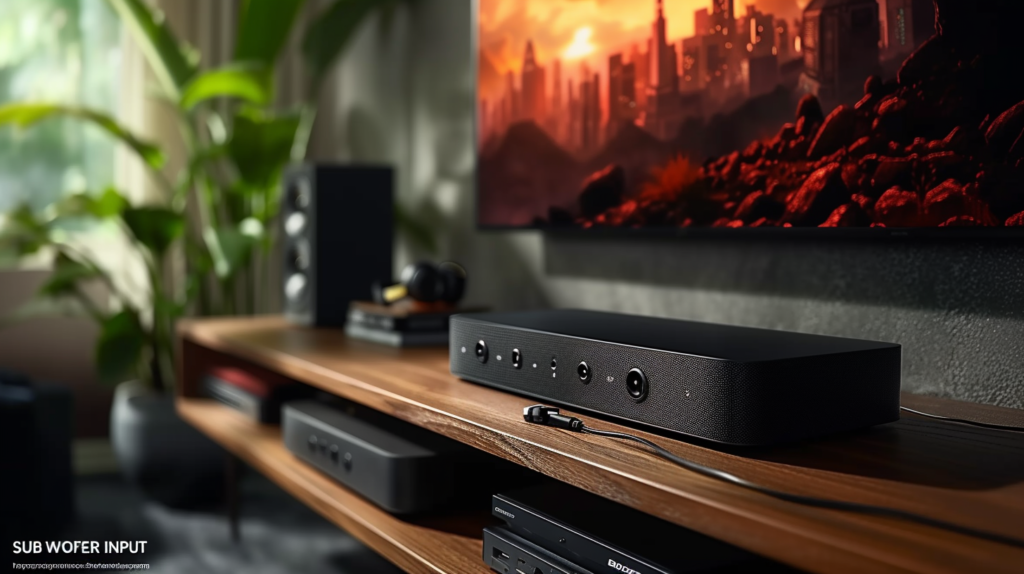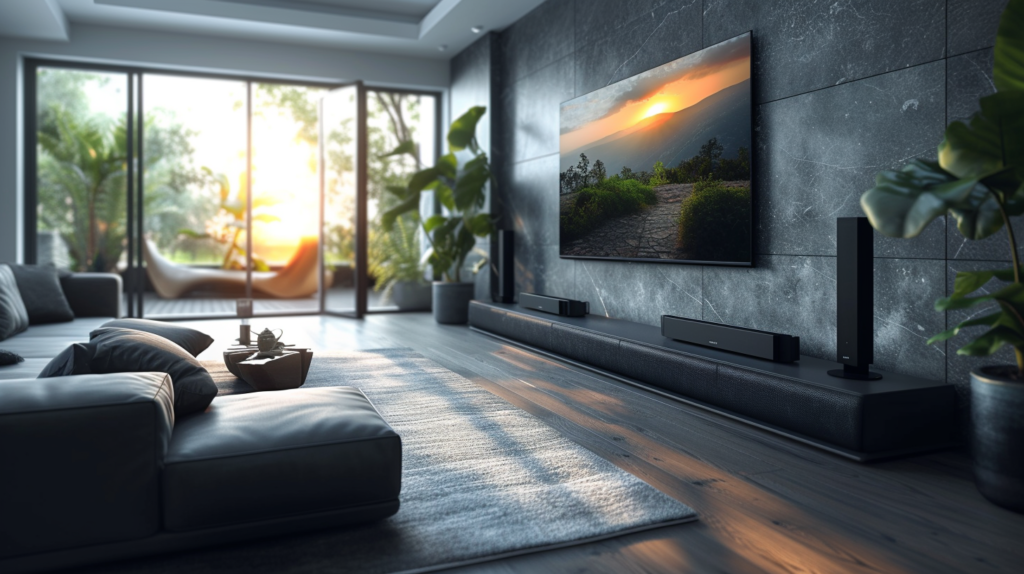Struggling to add thunderous bass to your Bose 900 soundbar?
Connecting an external Bose 700 subwoofer is an ideal solution, with just a few wiring and settings adjustments needed to perfectly integrate the speakers.
Let’s dive in to the step-by-step process for properly pairing these Bose components.
How to Connect a Bose 700 Subwoofer to a Bose 900 Soundbar

Connecting a Bose 700 subwoofer to a 900 soundbar requires just a few key steps – having the right cabling to physically join the speakers, wiring input and output ports properly, adjusting soundbar settings for subwoofer recognition, and tweaking levels to balance audio.
With care taken to firmly seat connectors and configure external bass response, rich subwoofer reinforcement can transform soundbar audio.
Let’s explore the complete process step-by-step.
What You Need

When getting ready to connect a Bose 700 subwoofer to a Bose 900 soundbar, having all the proper equipment ahead of time is an important first step.
There are only a few key items you need, but having them prepared before starting the process will make setup quicker and easier.
The first and most obvious items that you will require are the speakers themselves – the Bose 900 soundbar system and the Bose 700 powered subwoofer.
Make absolutely certain you have both speakers physically on hand and powered on before attempting to connect them.
Trying the connection process without both components powered on and ready will result in frustration.
Additionally, the Bose 700 subwoofer originally came packaged with a proprietary Bose subwoofer cable when it was purchased.
This specialized cable with connectors on each end provides the physical link between the Bose soundbar and subwoofer.
Check that you know exactly where this cable is located and that it is in good working condition before setting up your system.
Attempting to connect the speakers without the proper Bose subwoofer cable will simply not work.
If for some reason your cable is damaged or you cannot locate the included cable, you will need to order a replacement from Bose direct or an authorized Bose retailer.
Finally, having the remote controls for both the Bose 900 soundbar and Bose 700 subwoofer can come in handy as well.
While not absolutely necessary, they may simplify making adjustments like volume levels, EQ settings, etc once everything is connected.
But the most essential items are the speakers themselves and the connector cable that came with the Bose 700 subwoofer.
As long as you ensure those items are ready before starting, you will avoid frustration and be able to successfully connect the components.
Connecting the Subwoofer

With all the necessary equipment in hand, you can move forward with physically connecting the Bose 700 subwoofer to the Bose 900 soundbar.
The overall process is quite straightforward, with just a few simple wiring steps linking the components.
First, begin by locating the subwoofer output jack on the rear panel of the Bose 900 soundbar system.
It should be clearly labeled “SUBWOOFER” – possibly abbreviated to “SUB.” If for some reason you cannot locate the specific jack marked for subwoofer output, refer to the Bose 900 instruction materials for specifics on the port location.
Properly identifying the connection point is crucial, so take care to avoid plugging cables into an incorrect jack.
Once you have located and confirmed the subwoofer output, take note of its exact location on the rear soundbar panel.
Also make sure there is nothing currently plugged into that output jack.
Keeping track of this connection point will ensure you wire the external sub properly.
Now take the Bose subwoofer cable that originally came included with the Bose 700 subwoofer system.
On one end of this cable you will see a jack that matches the output port you located on the back of the Bose 900 soundbar.
Carefully insert this connector end completely into the subwoofer output jack on the soundbar, pressing firmly to ensure it is properly seated.
Having a tight, secure connection is vital for signal transmission.
With one end of the cable firmly connected to the rear soundbar panel, now shift focus to the Bose 700 powered subwoofer component.
Examine the rear panel of the subwoofer until you locate the jack specifically labeled “INPUT.”
Just as with the soundbar end, be absolutely certain you have identified the proper connection point marked for receiving input signals on the sub.
Once verified, take the open end of the included Bose subwoofer cable and insert it snugly into the INPUT jack on the subwoofer.
Press the wire firmly into the Input port until it is fully seated and connect.
Your Bose components are now physically connected via the proprietary sub cable.
All that remains is configuring signal transmission on the soundbar itself.
Configuring the Soundbar

After properly attaching the Bose 700 subwoofer to the Bose 900 soundbar system comes the simple process of configuring the soundbar to utilize the external sub.
This requires accessing the audio settings menu and specifying setup parameters to recognize the connected Bose sub component.
To begin configuration, verify that both the Bose 900 soundbar and the now wired Bose 700 subwoofer are powered on.
You should initially hear audio coming from just the soundbar itself.
This confirms a valid physical connection before signal adjustments are made.
Now locate the remote control that operates the Bose 900 sound system.
Visually scan the various buttons until you identify one labeled simply “Settings.” Selecting this
Settings button will open the on-screen menu for adjusting connected audio components and related options.
Accessing these controls is essential to integrating the subwoofer signals.
Use the arrow buttons on the remote to navigate through the Settings menu until you reach the option labeled “Speaker.”
Selecting Speaker will display configuration options related specifically to connected speaker elements like a paired subwoofer.
Arrow down within this Speaker sub-menu until you locate the option named “Subwoofer.” Accessing these Subwoofer controls is necessary for external subwoofer recognition.
After opening the Subwoofer settings category, use the left/right remote arrows to toggle the option labeled “External Subwoofer.”
Specifically designating an external, outboard sub is vital for allowing signal transmission from that Bose 700 component.
Essentially this step confirms for the soundbar brain that an additional subwoofer is now wired into the system.
Once External Subwoofer is selected in the Settings, use the remote arrows to navigate back out to the main Speaker adjustment menu.
Here you will see volume and EQ presets specifically tailored for that connected subwoofer.
Use these bass/treble options to achieve your desired audio balance between the soundbar and powered subwoofer.
Slowly raising subwoofer volume should result in robust bass fill from your Bose 700 sub reinforcing the soundbar output.
Take care to confirmation proper sound output from both the bar speaker array and wired sub at various volume levels and content.
Well-integrated bass is the mark of a properly transmitted and balanced subwoofer signal.
If bass is too “boomy” or overpowering, simply tweak levels or EQ in the Settings menu accordingly.
Troubleshooting Tips

When executed carefully as detailed above, connecting and integrating at Bose 700 subwoofer with a Bose 900 soundbar is usually quick and straightforward.
However, if for some reason you encounter difficulties achieving solid subwoofer output and performance, there are couple basic troubleshooting tips to help resolve potential issues.
First and foremost, verify that all physical cable connections between the Bose soundbar and subwoofer components are firmly and properly attached.
Use care when inserting subwoofer cables into their respective ports, pressing firmly to ensure the jacks are completely seated.
Try removing and reattaching wires into input/output ports if you experience no bass signals.
Clean connector pins can also help strengthen signal continuity.
Confirm that cables are not damaged and that you are using the proprietary Bose wires designed for this speaker pairing.
Additionally, attempt powering the Bose soundbar and subwoofer from different electrical sources in your room.
On very rare occasions, humming or interference when components share the same exact outlet can impede clean audio signals.
Separate just the power sources to rule out any disruption.
Also be sure to position the subwoofer several feet away from the soundbar itself along with other potential electronic interference like wireless routers.
Too close proximity to other devices can again in some cases impact clean signal transmission, especially strong bass frequencies.
If problems connecting and utilizing your Bose 700 sub persist after verification of secure wiring and positioning adjustments, the next recommendation is performing a factory reset on both the soundbar and subwoofer components.
Refer to your Bose reference guides for proper steps to restore original settings.
A clean reboot clearing any legacy settings can allow the system to re-initialize properly.
Be aware that custom presets will be cleared as well so make note if you want to preserve those.
Finally, as a last resort you can try reaching out directly to Bose technical support for additional troubleshooting advice if they cannot resolve connection issues on your own.
Bose personnel have extensive experience pairing these speaker components and can offer specialized suggestions.
Be prepared to provide detailed specifics on your setup, connections, troubleshooting already attempted, and the exact nature of the problem.
They will likely have additional advanced steps to try achieving solid subwoofer integration.
While most users easily achieve a successful sub and soundbar pairing on their own per the instructions above, know that options for additional support to overcome problems are available from Bose customer service.
Getting great bass enhancement from your Bose 700 sub is well worth the effort to resolve any wiring or configuration difficulties that arise.
With some focused troubleshooting care, seamless audio specifically from intricately paired Bose components is definitely obtainable for even novice users.
Conclusion
In conclusion, connecting a Bose 700 subwoofer to a Bose 900 soundbar is generally a straightforward process with the right cables and configuration.
Following the step-by-step instructions above regarding proper physical wiring and soundbar settings should result in robust, seamless bass response from the paired subwoofer.
Should issues arise, there are various basic troubleshooting tips to try before seeking assistance from Bose support directly.
With some care taken to component selection, setup, and testing, users should be able to achieve excellent audio quality and reinforcement from adding a Bose 700 sub to their existing Bose 900 sound system.
